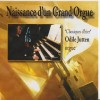Composers
Antonio de Cabezón (30 March 1510 – 26 March 1566) was a Spanish Renaissance composer and organist. Blind from childhood, he quickly rose to prominence as performer and was eventually employed by the royal family. He was among the most important composers of his time and the first major Iberian keyboard composer.
Cabezón was born in Castrillo Matajudíos, a municipality near Burgos, in the north of Spain. Nothing is known about his formative years. He became blind in early childhood, and he may have been educated at the Palencia Cathedral by the organist there, García de Baeza. At the time, the country was slowly entering its Golden Age. On 14 March 1516 Charles V was proclaimed King of Castile and of Aragon jointly with his mother, the first time the crowns of Castile and Aragon were united under the same king. After the death of his paternal grandfather, Maximilian, in 1519, Charles also inherited the Habsburg lands in Austria, and later went on to become Emperor of the Holy Roman Empire and one of the most powerful monarchs in the world.
In 1525 Charles married Isabella of Portugal, further strengthening his position in Spain. It was Isabella who employed Cabezón into her service in 1526. His duties included playing the clavichord and the organ, and he also assumed the position of organist at the chapel Isabella organized soon after her wedding. The composer remained with the royal family for the rest of his life. Through the court, he met such important composers as vihuelist Luis de Narváez, known today for his advanced polyphonic fantasias, and Tomás de Santa María, theorist and composer whose important treatise on instrumental music, Arte de tañer fantasía, was examined and approved by Cabezón.
In 1538 Cabezón was made músico de la cámara (chamber musician) to Charles (who was educated in music as a child, by noted organist Henry Bredemers). After Isabella's death in 1539 Cabezón was appointed music teacher to her children: Prince Felipe and his sisters Maria and Joan (Maria would later become the most important patron of composer Tomás Luis de Victoria). In 1543 Felipe became Regent of Spain, and he made Cabezón his court organist. Cabezón's duties included playing a portative organ for Felipe on his journeys. On 19 July 1546 Cabezón's brother Juan, also an organist and composer, was appointed musician in the royal chapel of Prince Felipe. Since the late 1540s Antonio and Juan both accompanied Felipe on his various trips, and visited Italy, the Netherlands, Germany (in 1548–49), and England (in 1554–56), where Antonio's variations may have influenced Byrd and Tallis, who latter took up the form.[1]
Practically nothing is known about Cabezón's personal life. He married one Luisa Nuñez de Mocos from Ávila, and the couple had five children. One of Antonio's sons, Hernando de Cabezón (1541–1602) became a composer and it was through his efforts that the bulk of Antonio's oeuvre was preserved. Another son, Agustín de Cabezón (died before 1564), became a chorister of the royal chapel.[1] Cabezón died in Madrid on 26 March 1566.
Recently Added
| Country: | Spain |
| Period: | Renaissance |
Biography
Antonio de Cabezón (30 March 1510 – 26 March 1566) was a Spanish Renaissance composer and organist. Blind from childhood, he quickly rose to prominence as performer and was eventually employed by the royal family. He was among the most important composers of his time and the first major Iberian keyboard composer.
Cabezón was born in Castrillo Matajudíos, a municipality near Burgos, in the north of Spain. Nothing is known about his formative years. He became blind in early childhood, and he may have been educated at the Palencia Cathedral by the organist there, García de Baeza. At the time, the country was slowly entering its Golden Age. On 14 March 1516 Charles V was proclaimed King of Castile and of Aragon jointly with his mother, the first time the crowns of Castile and Aragon were united under the same king. After the death of his paternal grandfather, Maximilian, in 1519, Charles also inherited the Habsburg lands in Austria, and later went on to become Emperor of the Holy Roman Empire and one of the most powerful monarchs in the world.
In 1525 Charles married Isabella of Portugal, further strengthening his position in Spain. It was Isabella who employed Cabezón into her service in 1526. His duties included playing the clavichord and the organ, and he also assumed the position of organist at the chapel Isabella organized soon after her wedding. The composer remained with the royal family for the rest of his life. Through the court, he met such important composers as vihuelist Luis de Narváez, known today for his advanced polyphonic fantasias, and Tomás de Santa María, theorist and composer whose important treatise on instrumental music, Arte de tañer fantasía, was examined and approved by Cabezón.
In 1538 Cabezón was made músico de la cámara (chamber musician) to Charles (who was educated in music as a child, by noted organist Henry Bredemers). After Isabella's death in 1539 Cabezón was appointed music teacher to her children: Prince Felipe and his sisters Maria and Joan (Maria would later become the most important patron of composer Tomás Luis de Victoria). In 1543 Felipe became Regent of Spain, and he made Cabezón his court organist. Cabezón's duties included playing a portative organ for Felipe on his journeys. On 19 July 1546 Cabezón's brother Juan, also an organist and composer, was appointed musician in the royal chapel of Prince Felipe. Since the late 1540s Antonio and Juan both accompanied Felipe on his various trips, and visited Italy, the Netherlands, Germany (in 1548–49), and England (in 1554–56), where Antonio's variations may have influenced Byrd and Tallis, who latter took up the form.[1]
Practically nothing is known about Cabezón's personal life. He married one Luisa Nuñez de Mocos from Ávila, and the couple had five children. One of Antonio's sons, Hernando de Cabezón (1541–1602) became a composer and it was through his efforts that the bulk of Antonio's oeuvre was preserved. Another son, Agustín de Cabezón (died before 1564), became a chorister of the royal chapel.[1] Cabezón died in Madrid on 26 March 1566.

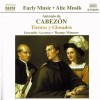
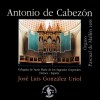
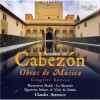
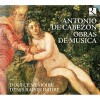
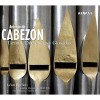
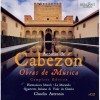
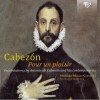
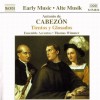


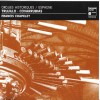
![Great European Organs. 39-Nicholas Jackson [Segovia Cathedral]](http://static.classicalm.com/repository/collection-cover/small/917-img1341761014261487.jpg)
![Het Historische Orgel in Nederland [CD 6 of 20]](http://static.classicalm.com/repository/collection-cover/small/991-img1343307195166706.jpg)
